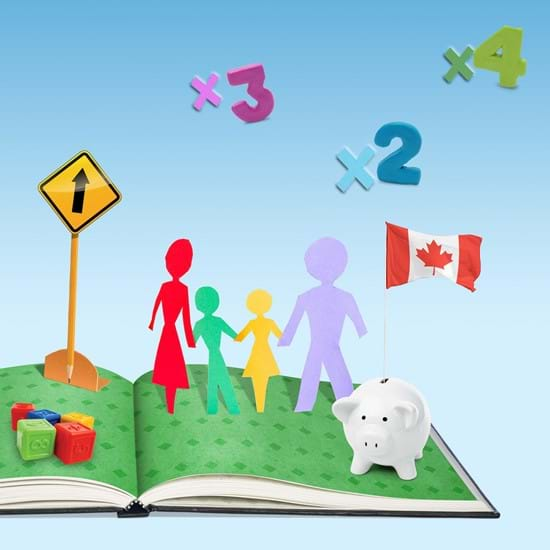
How can I manage and improve my credit rating?
When you rented or purchased a home, applied for a credit card or bought a car, you probably heard the term “credit rating” or “credit score.” But how is a credit rating calculated and used? What impact does it have on your loans? To find out more, check out this financial column by financial planner Julie St-Cyr.
Why is a good credit rating important?
Your credit rating is one of the pieces of information in your credit report. It helps lenders assess the level of risk when they give you credit or a loan. In other words, creditors want to know that your loan will be repaid, your credit payments made on time and your rent paid.
If you have a good credit rating, you’ll find it easier to obtain credit, a line of credit, a loan, a home or a vehicle, and you may get better interest rates.
What number is considered a good credit rating?
Calculated using a mathematical formula, your credit rating is a number between 300 and 900 that determines your creditworthiness:
- Between 660 and 900 is considered good, very good or excellent
- Below 660 makes you less likely to qualify for better credit terms
- Below 560 is considered poor, which means more difficulty obtaining credit or a low-interest loan
However, lenders use different credit rating models depending on the business they’re in. As a result, the values obtained may differ significantly.
Even though a high rating is preferable, there is no perfect value for getting the best rates and terms, as each financial situation is unique1.
How is your credit rating determined2?
Your credit rating is based on five factors that affect your score:
- Your payment history (35% of score): Payments overdue by more than 30 days are noted in your report for several years, regardless of the amount.
- Your credit utilization (30% of score): Using more than 50% of your credit card or line of credit can affect your credit score, even if you repay the entire amount by the end of the month.
- When you opened the account (15% of score): An account you’ve had for a long time makes it easier to assess your ability to repay.
- New credit applications (10% of score): Every new credit application is noted in your report. Applying for too many loans can be considered a debt risk and negatively affect your rating.
- Number and variety of creditors (10% of score): You can have several different accounts (personal, mortgage and car loans, line of credit, etc.), but not of the same type (such as several credit cards).
How can I find out my credit score quickly and easily?
You can check your credit rating with most financial institutions free of charge, in the same way as you check your debit or credit card balance. However, you won’t be able to request a correction if there’s an error.
No matter what your plans are when it comes to applying for credit, developing good financial management habits, such as regularly using a budget template and cutting expenses, will help you maintain a high credit rating.
Your credit rating is the key to your financial plans as it is used to assess your ability to pay your debts.
Your credit score is always changing; it goes up and down based on your financial behaviour. There are many ways to improve it; it’s never too late to form good habits!
How can I improve my credit rating?
If your credit rating is low or poor, there are a number of ways you can improve it over time:
- Create a budget showing your income, expenses and possible ways to saving money
- Make your credit card and line of credit payments on time and in full
- Pay your bills on time and in full
- Don’t use all your available credit, and don’t exceed 50% of your credit limit; if you can, don’t use more than 35% of your total credit
- Keep your oldest accounts open so you’ll have a long-term credit history
- Check your credit report before applying for a loan to correct any errors
- Keep only one credit card, preferably the oldest one
- Vary your types of active loans—car, credit card or mortgage—as long as they are of different types
- Limit the number of times you apply for credit; if you make multiple applications in two weeks, they will count as a single check of your report
- Staying at the same address for a few years and holding down a steady job can also help improve your credit rating in Canada
How can I use a credit card to increase my score?
Ask your financial institution for a credit card with a security deposit. Your bank will then ask you to make a deposit to secure your credit limit. The maximum limit will be $1,000. This may be a good way to get back on track, especially after bankruptcy.
Who can check a credit rating and why?
Credit-reporting agencies are subject to rules that determine who can look at your credit report. Generally speaking, these are people, organizations and companies with whom you will be doing business, such as the following:
- A financial institution for a loan, line of credit or credit card
- A landlord when you sign a lease for your apartment
- A car dealer when you buy or lease a vehicle
- A business when you apply for credit to buy electronics, furniture, household appliances, etc.
- An insurance company you want coverage from
- An employer as part of a hiring process
Who establishes the credit score?
All the information in your credit report, such as your credit score, is collected, updated, compiled and stored by two agencies in Canada: Equifax and TransUnion. The information relates to Canadian creditors only. The two agencies may share your credit rating and credit report information with authorized individuals, companies and organizations upon request.
How do I get my credit report?
The credit report provides a summary of your credit history. It is automatically created when you first apply for credit or borrow money.
You can get your credit report and rating free of charge online from Equifax or TransUnion. You can also request a copy of your report in writing, several times a year. Such requests are recorded in your report but do not affect your credit score.
What’s in my credit report2?
Your report contains information that is updated over time with data sent to the credit bureaus by various debtor organizations. It includes the following:
- Your identification: Name, address, date of birth, employer, telephone number and social insurance number
- Your credit accounts: Credit cards, lines of credit, mortgages, student loans, consumer loans, etc.
- Your repayment habits and behaviours
- Information about all your Canadian bank accounts and any NSF cheques or insufficient funds
- Information about any unpaid accounts or debts supervised by a collection agency
- Public information about you, if appropriate, such as a bankruptcy or judgment against you
- The names of people who have requested access to your credit report (companies and organizations)
- Your credit rating, of course!
The information that goes into your credit report, which contains your credit rating, is provided by companies, organizations and service providers such as the following:
- Your financial or banking institution
- Your cellular, cable or Internet service provider
- Your credit card provider
Please note that your advance consent is required for any request to provide your credit report, and therefore your credit rating, to a third party.
Julie St-Cyr, Financial Planner




